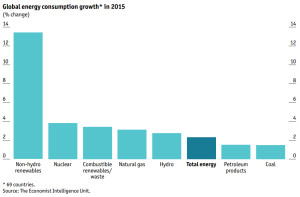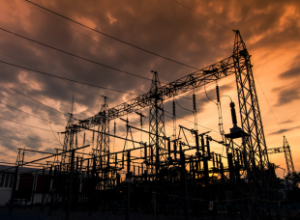RE and EE Carbon Policy news 16 January 2015
Weekly RE and EE Carbon Policy news update from the web.
The Year Ahead: Top Clean Energy Trends of 2015

For the past 13 years, Clean Edge has published the annual Clean Energy Trends report that has sized the global market for solar, wind, and biofuels and tracked everything from venture capital and stock market activity to total global investments. This year, instead of issuing one single report, we’ll be producing infographics, tables, charts, and webinars throughout the year – so be on the lookout in the coming weeks and months.
In the annual report, we also picked our top trends to watch for the coming year. Here are our top trends that matter in 2015:
• Moves Toward 100 Percent Renewables Will Expand
• Energy Storage will Carve out a Competitive Advantage
• Low-Cost Oil Could Impact Clean Transportation, but not Clean Electricity
• Other Regions will Follow New York Fracking Lead
Let’s take a closer look at the top trends and how they are likely to impact markets in 2015.
EIU: Renewable energy demand to significantly outgrow fossil fuels in 2015

Demand for renewable energy is predicted to increase by 13% in 2015 as ‘dirty coal goes out of fashion’ and global governments impose tighter environmental rules.
That’s according to a report from the Economist Intelligence Unit, Industries in 2015, which suggests that the growth in renewables will outpace that of petroleum and coal, and energy companies will feel the impact of low oil, gas and coal prices in 2015.
By December, a global climate change treaty, replacing the Kyoto Protocol, is likely to be signed at the 2015 United Nations Climate Change Conference in Paris. But, ahead of the talks, the report argues that non-fossil fuels still lack the overarching policy support they need to make faster progress globally.
“In 2009, the world tried and failed to hammer out a replacement for the Kyoto Protocol,” the report reads. “Some form of new pact is indeed likely to be signed, perhaps incorporating voluntary, scalable targets for individual countries. Whether it will be equal to the task of keeping global warming within safe bounds is far more doubtful.”
EPA to Issue Carbon Rules by Summer

Three of the most sweeping federal regulations of power plant carbon emissions in U.S. history will be finalized all at once this summer, the Environmental Protection Agency announced Wednesday – an attempt, some experts say, to fend off legal challenges to the controversial climate change measures.
Separate emissions standards for new, modified and existing power plants will be completed “by mid-summer 2015,” Janet McCabe, acting assistant administrator for EPA’s Office of Air and Radiation, said in a call with reporters. They are the first ever that would rein in carbon dioxide emissions from power plants and together form a cornerstone of President Barack Obama’s second-term efforts to address climate change.
[READ: White House Vows to Veto Keystone XL Pipeline Bill]
The rule for new power plants was proposed in September 2013. The standards for modified and existing plants were unveiled in June, part of a proposed Clean Power Plan that would set emissions goals for individual states based on their energy portfolios and resources. States would then be required to submit emissions plans to meet those targets.
In a first on Wednesday, however, the EPA also announced that it will develop a federal plan for states that fail to provide a plan or meet the agency’s emissions criteria, which it says are enforceable through the Clean Air Act.
Forest Carbon News – January 8, 2015

For this New Year’s edition of Forest Carbon News, we asked market experts to look into their crystal balls and answer the following question:
What are your predictions for the forest carbon markets in 2015? What policy, science, economic, and other developments could impact the market?
Carbon pricing coming to Ontario, strategy to be unveiled this year

The Ontario government is closing in on a plan to put a price on carbon emissions after nearly seven years of delays.
The Liberals have promised to make corporations and consumers pay for burning carbon – an effective way to battle global warming – since 2008, but have put off making a decision. However, Environment Minister Glen Murray is now working on a comprehensive plan to slash greenhouse gas emissions, and he pledges carbon pricing will be part of it.
Cut carbon pollution, create clean energy jobs: Legislative priorities 2015

Climate change—and climate action—top the list of big issues before the Washington state Legislature in this year’s session, which kicks off today. Jobs and education also top the list of priorities for 2015; it will be an important, and likely exciting, few months in Olympia. For one thing, this is a biennial “full session” in which lawmakers adopt a budget, often after debating late into the spring. Climate-related bills on deck this year include a proposal to clean up our air and water by charging top polluters, and a whole slate of measures related to clean energy and jobs.
Solar power drives renewable energy investment boom in 2014

Global investment in clean energy jumped 16% in 2014, boosted by fast-growing solar power in the US and China. Solar, whose costs have plummeted in recent years, attracted over half the total funding for the first time.
The green energy market has been gloomy in recent years and the rise in investment is the first since 2011. But despite strong growth in most regions, only a series of large offshore wind farms stopped Europe going into reverse, while the Australian government’s antipathy to renewables saw investment there tumble by 35%.
The new figures, from Bloomberg New Energy Finance (BNEF), show $310bn (£205bn) was ploughed into green energy last year, just short of the record $317bn in 2011. However, as green energy gets ever cheaper, the money invested in 2014 bought almost double the clean electricity capacity than in 2011.
“The investment bounce back in 2014 exceeded our expectations,” said Michael Liebreich, chairman of BNEF’s advisory board. “Solar was the biggest single contributor, thanks to the huge improvements in its cost-competitiveness over the last five years.”
Morocco Heads toward Renewable Energy

Morocco’s [muh-ROK-oh] long-term plan to produce renewable energy is underway.
The country is investing to build five solar thermal power plants in five years. Through this project, the government hopes to supply Morocco’s growing energy consumption with solarenergy.
Morocco plans to make use of solar energy as its main power source. Currently, Morocco’s oil and gas resources are scarce, with half of its energy source dependent on coal. The country will also enter a business trade of clean energy with Europe should the project succeed. The five power plants are estimated to produce a total of 2,000 megawatts.
Clean energy sector ‘uninvestable’ due to renewable energy target uncertainty, analyst says

Uncertainty surrounding the renewable energy target (RET) has made the large-scale sector of the industry in Australia “uninvestable”, a clean energy analyst says.
A report by Bloomberg New Energy Finance said large-scale energy investment fell 88 per cent – to $240 million – in 2014 compared to the previous year.
It was the lowest level since 2002, the report said.
Top 10 Carbon Market Predictions for 2015

Last week, the Climate Trust, a mission-driven nonprofit that specializes in climate solutions, with a reduction of 1.9 million tons of greenhouse gases to its name, announced its second annual prediction list of 10 carbon market trends to watch in 2015.
The trends, which range from increased climate change adaptation measures at the state and city-level to new protocols for agriculture and forestry, were identified by the Climate Trust based on interactions with their diverse group of working partners—government, utilities, project developers and large businesses.
“We’re excited to once again look at the overall market with fresh eyes and identify areas of potential movement and growth,” said Dick Kempka, vice president of business development for The Climate Trust.
Road to Paris 2015: How do we value carbon?

Climate Change Capital’s James Cameron reflects on the barriers that need to be overcome if the world is to agree an ambitious climate change treaty.
James Cameron, chairman of Climate Change Capital, looks ahead to the Paris 2015 talks and shares his hopes and expectations for an international climate agreement and a price for carbon that businesses and investors can respond to.
This video is hosted in association with Climate Change Capital
Why California Needs to Think Differently About How It Supports Energy Efficiency

The imperative to change the way California implements energy efficiency is compelling and immediate. California’s energy efficiency programs are not meeting today’s grid-scale and local distribution service challenges, nor are they capable of supporting the state’s climate goals.
Even with the state’s massive ratepayer-funded efficiency programs since the 2000-2001 energy crisis, energy use and peak loads have increased, and they are forecast to continue to grow. Peak demand (absolute and per capita, noncoincident) has been increasing and is projected to increase at rates greater than the growth in energy consumption. The state’s most important tool for addressing greenhouse gas emissions in the energy sector is energy efficiency.
However, about one-third of California’s annual efficiency savings since 2000-2001 has been achieved from short-lived fluorescent lamps. As a result, cumulative savings are decaying over time. Generally, utilities have discounted the installed fluorescent lamps, while counting replacements as new savings toward long-term cumulative savings. This contributes to an overstatement of efficiency accomplishments.